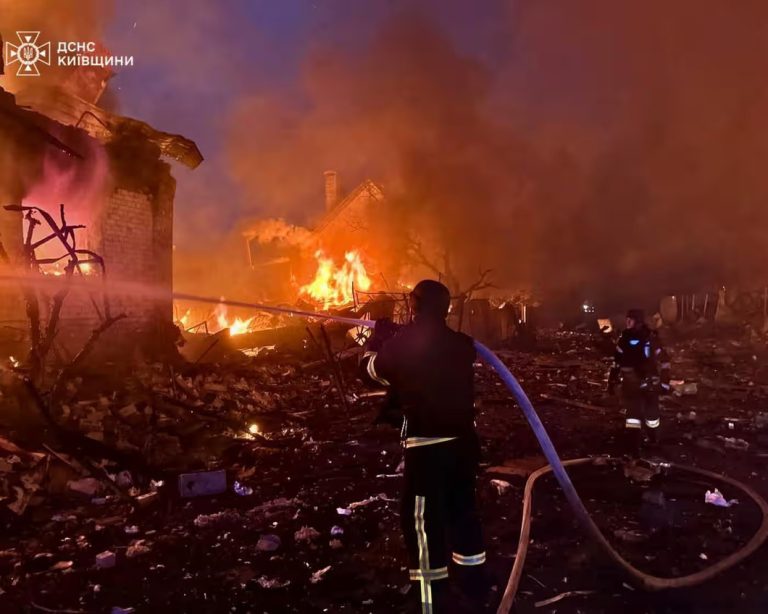Russia unleashed its most extensive aerial assault in the three-year war with Ukraine, targeting the capital, Kyiv, in a second consecutive night of heavy drone and missile strikes.
Officials reported at least 13 fatalities nationwide, including three children in the Kyiv region, with many more injured. Casualty figures and damage assessments began to emerge on Sunday morning, revealing the scope of the overnight attacks.
Ukraine’s military confirmed that Russia had fired 298 drones and 69 missiles in several waves throughout the night. In response, Russia’s defense ministry claimed its own air defenses had downed 110 Ukrainian drones aimed at its territory.
President Volodymyr Zelenskyy condemned the strikes and criticized what he described as a lack of international response.
“America’s silence, and the silence of others around the world, only emboldens Putin,” Zelenskyy wrote on Telegram. “Each of these terrorist attacks is reason enough for new sanctions against Russia.”
Despite the latest violence, Zelenskyy expressed hope that a large-scale prisoner exchange, negotiated last week in Istanbul, would move forward. The swap—set to include hundreds of detainees on both sides—would mark a rare instance of cooperation amid an otherwise deadlocked conflict.
Russian attacks struck across Ukraine from Saturday night into Sunday, hitting areas from the eastern front to the western interior and southern coastline. Four deaths were reported in the Khmelnytskyi region in the west, four more in the Kyiv region, and one in Mykolaiv in the south.
Sergiy Tyurin, deputy head of the Khmelnytskyi military administration, said the region sustained serious damage to civilian infrastructure. “Unfortunately, four people were killed,” he wrote on Telegram.
In the Kyiv region, emergency services confirmed four fatalities and 16 injuries from what they described as a “massive overnight assault,” including the deaths of three children.
Kyiv Mayor Vitali Klitschko said at least 10 people had been injured by 3 a.m., with a student dormitory in the Holosiivskyi district hit by a drone. One of the building’s outer walls caught fire.
The scale and intensity of the weekend’s air raids starkly contradicted former U.S. President Donald Trump’s recent assertions that Russian President Vladimir Putin is interested in peace. Trump, who has been promoting his potential to broker a settlement, has yet to comment on the fresh wave of attacks. For Kyiv residents, the city’s annual Kyiv Day, celebrated on the last Sunday of May, began under siege, with families sheltering in basements, metro stations, and air raid bunkers.
Strikes were also reported in Odesa, Dnipro, Sumy, Konotop, Chernihiv, Ternopil, Kharkiv, and Mykolaiv, according to local reports.
The drone assault reportedly began around midnight on Saturday, followed by ballistic missile alerts. A Guardian reporter in Kyiv described hearing several drones reaching the city center, triggering loud explosions despite air defense efforts.
Meanwhile, Russian officials claimed to have shot down a dozen Ukrainian drones headed toward Moscow.
In Kyiv, the head of the city’s military administration, Tymur Tkachenko, warned residents early in the night: “This will not be an easy night.” Using air raid alert apps, locals tracked multiple drone waves approaching the capital. At one point, Tkachenko reported more than a dozen drones hovering over the area.
“Some have already been intercepted, but new ones are still arriving,” he posted.
Ukraine and its European allies have been pushing for a 30-day ceasefire as a starting point for broader peace talks. However, efforts took a hit this week when Trump declined to impose further sanctions on Russia for rejecting a temporary truce.
Andriy Yermak, Zelenskyy’s chief of staff, voiced his frustration on Telegram: “Without pressure, nothing will change. Russia and its partners will only grow stronger and bring this kind of violence to the West.”
“Moscow will continue to fight as long as it can produce weapons,” he added.

